Low Impact Manufacturing Report: Module Assignment - Circular Economy
VerifiedAdded on 2023/01/19
|17
|4325
|94
Report
AI Summary
This report delves into the concept of low impact manufacturing, specifically examining the circular economy model and its application within the motorcycle industry. The introduction highlights the challenges of efficient disposal and the need for sustainable growth through waste recycling, renewable energy, and the elimination of toxic waste. The objectives focus on addressing the gap in research regarding the circular economy within the motorcycle industry in the UK. A comprehensive literature review explores the circular economy's various facets, including geographical applications, government involvement, and the effectiveness of circular economy policies. The methodology section details the recycling processes for various motorcycle components, including structural parts like chassis, wheels, and brakes; electrical components like batteries and circuit boards; and miscellaneous parts like tires and bodywork. The discussion section addresses short-term and long-term measures, as well as a future sustainable industrial plan. The report concludes with recommendations for implementing circular economy principles in the motorcycle industry, emphasizing the importance of material recovery, waste reduction, and sustainable manufacturing practices. The report provides an in-depth analysis of the circular economy, offering insights into sustainable practices in the manufacturing industry.
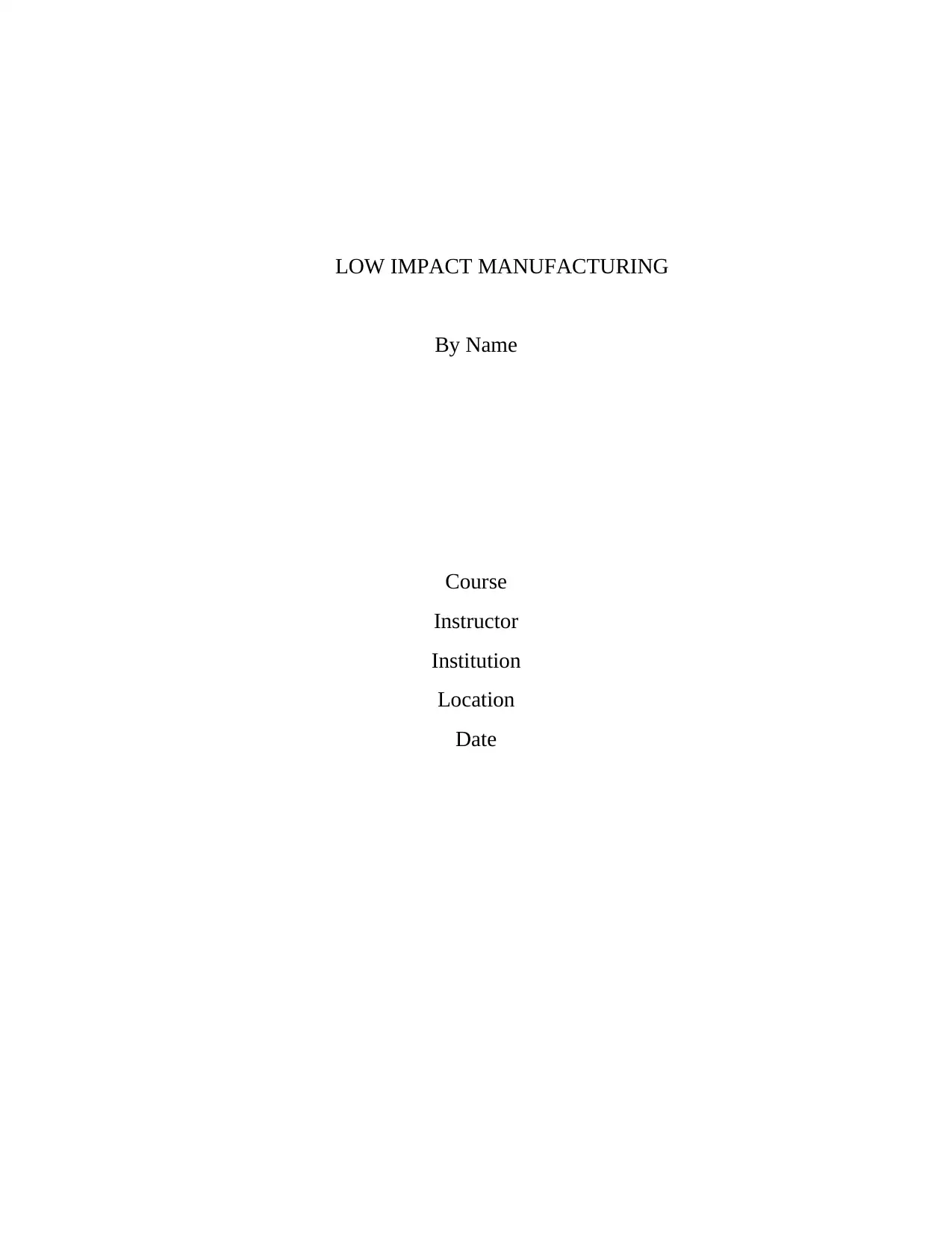
LOW IMPACT MANUFACTURING
By Name
Course
Instructor
Institution
Location
Date
By Name
Course
Instructor
Institution
Location
Date
Paraphrase This Document
Need a fresh take? Get an instant paraphrase of this document with our AI Paraphraser
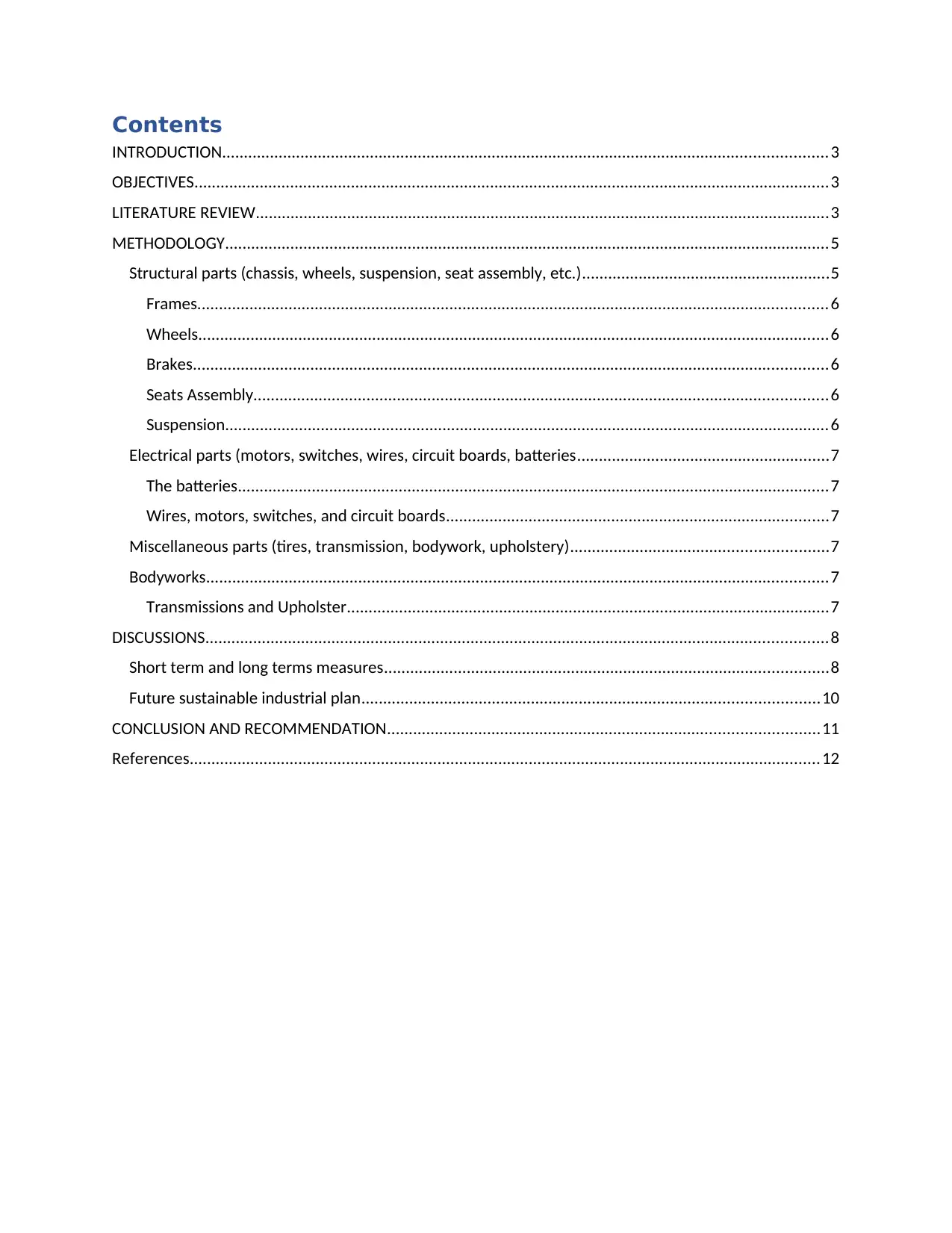
Contents
INTRODUCTION...........................................................................................................................................3
OBJECTIVES..................................................................................................................................................3
LITERATURE REVIEW....................................................................................................................................3
METHODOLOGY...........................................................................................................................................5
Structural parts (chassis, wheels, suspension, seat assembly, etc.).........................................................5
Frames.................................................................................................................................................6
Wheels.................................................................................................................................................6
Brakes..................................................................................................................................................6
Seats Assembly....................................................................................................................................6
Suspension...........................................................................................................................................6
Electrical parts (motors, switches, wires, circuit boards, batteries..........................................................7
The batteries........................................................................................................................................7
Wires, motors, switches, and circuit boards........................................................................................7
Miscellaneous parts (tires, transmission, bodywork, upholstery)...........................................................7
Bodyworks...............................................................................................................................................7
Transmissions and Upholster...............................................................................................................7
DISCUSSIONS...............................................................................................................................................8
Short term and long terms measures......................................................................................................8
Future sustainable industrial plan.........................................................................................................10
CONCLUSION AND RECOMMENDATION...................................................................................................11
References.................................................................................................................................................12
INTRODUCTION...........................................................................................................................................3
OBJECTIVES..................................................................................................................................................3
LITERATURE REVIEW....................................................................................................................................3
METHODOLOGY...........................................................................................................................................5
Structural parts (chassis, wheels, suspension, seat assembly, etc.).........................................................5
Frames.................................................................................................................................................6
Wheels.................................................................................................................................................6
Brakes..................................................................................................................................................6
Seats Assembly....................................................................................................................................6
Suspension...........................................................................................................................................6
Electrical parts (motors, switches, wires, circuit boards, batteries..........................................................7
The batteries........................................................................................................................................7
Wires, motors, switches, and circuit boards........................................................................................7
Miscellaneous parts (tires, transmission, bodywork, upholstery)...........................................................7
Bodyworks...............................................................................................................................................7
Transmissions and Upholster...............................................................................................................7
DISCUSSIONS...............................................................................................................................................8
Short term and long terms measures......................................................................................................8
Future sustainable industrial plan.........................................................................................................10
CONCLUSION AND RECOMMENDATION...................................................................................................11
References.................................................................................................................................................12
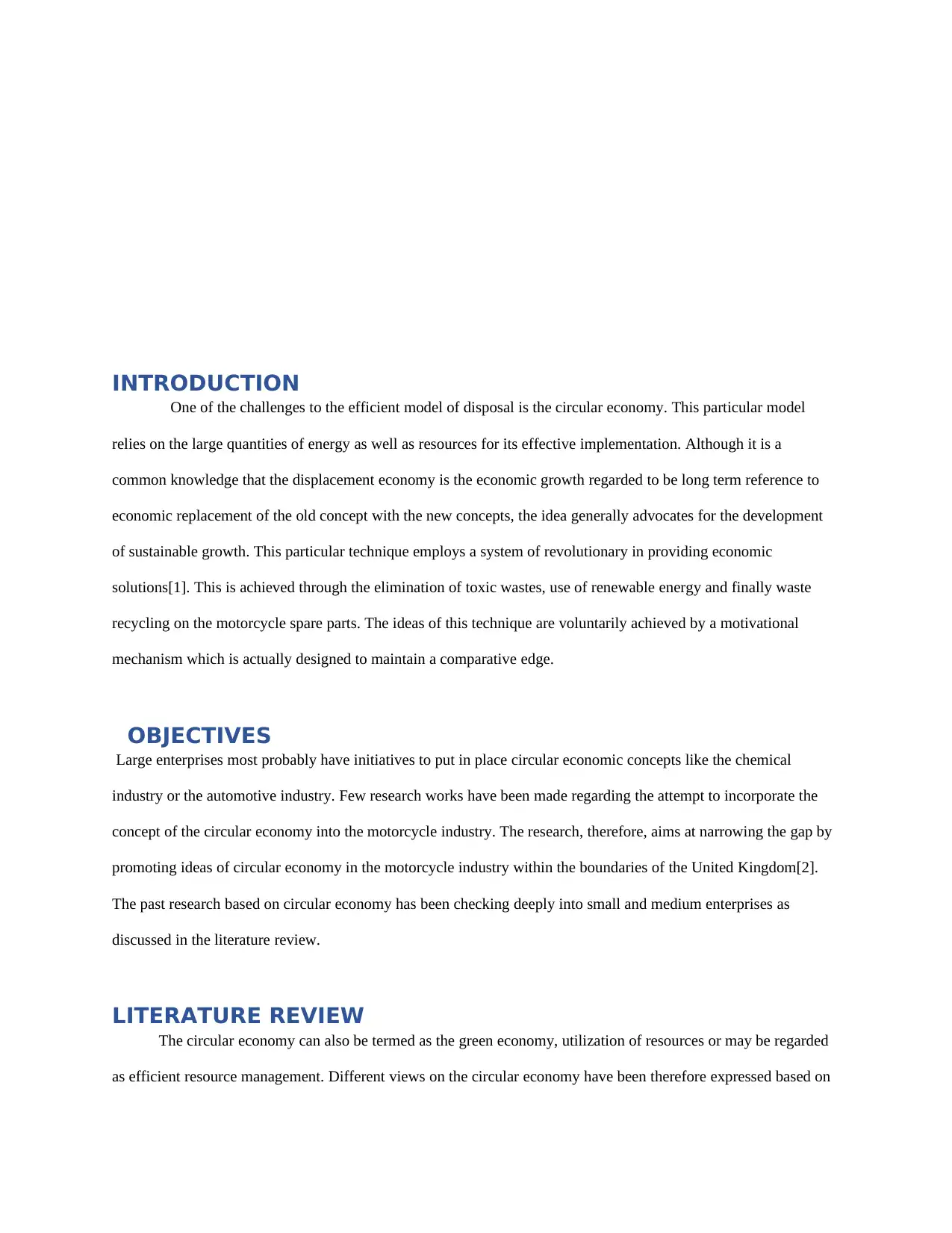
INTRODUCTION
One of the challenges to the efficient model of disposal is the circular economy. This particular model
relies on the large quantities of energy as well as resources for its effective implementation. Although it is a
common knowledge that the displacement economy is the economic growth regarded to be long term reference to
economic replacement of the old concept with the new concepts, the idea generally advocates for the development
of sustainable growth. This particular technique employs a system of revolutionary in providing economic
solutions[1]. This is achieved through the elimination of toxic wastes, use of renewable energy and finally waste
recycling on the motorcycle spare parts. The ideas of this technique are voluntarily achieved by a motivational
mechanism which is actually designed to maintain a comparative edge.
OBJECTIVES
Large enterprises most probably have initiatives to put in place circular economic concepts like the chemical
industry or the automotive industry. Few research works have been made regarding the attempt to incorporate the
concept of the circular economy into the motorcycle industry. The research, therefore, aims at narrowing the gap by
promoting ideas of circular economy in the motorcycle industry within the boundaries of the United Kingdom[2].
The past research based on circular economy has been checking deeply into small and medium enterprises as
discussed in the literature review.
LITERATURE REVIEW
The circular economy can also be termed as the green economy, utilization of resources or may be regarded
as efficient resource management. Different views on the circular economy have been therefore expressed based on
One of the challenges to the efficient model of disposal is the circular economy. This particular model
relies on the large quantities of energy as well as resources for its effective implementation. Although it is a
common knowledge that the displacement economy is the economic growth regarded to be long term reference to
economic replacement of the old concept with the new concepts, the idea generally advocates for the development
of sustainable growth. This particular technique employs a system of revolutionary in providing economic
solutions[1]. This is achieved through the elimination of toxic wastes, use of renewable energy and finally waste
recycling on the motorcycle spare parts. The ideas of this technique are voluntarily achieved by a motivational
mechanism which is actually designed to maintain a comparative edge.
OBJECTIVES
Large enterprises most probably have initiatives to put in place circular economic concepts like the chemical
industry or the automotive industry. Few research works have been made regarding the attempt to incorporate the
concept of the circular economy into the motorcycle industry. The research, therefore, aims at narrowing the gap by
promoting ideas of circular economy in the motorcycle industry within the boundaries of the United Kingdom[2].
The past research based on circular economy has been checking deeply into small and medium enterprises as
discussed in the literature review.
LITERATURE REVIEW
The circular economy can also be termed as the green economy, utilization of resources or may be regarded
as efficient resource management. Different views on the circular economy have been therefore expressed based on
⊘ This is a preview!⊘
Do you want full access?
Subscribe today to unlock all pages.

Trusted by 1+ million students worldwide
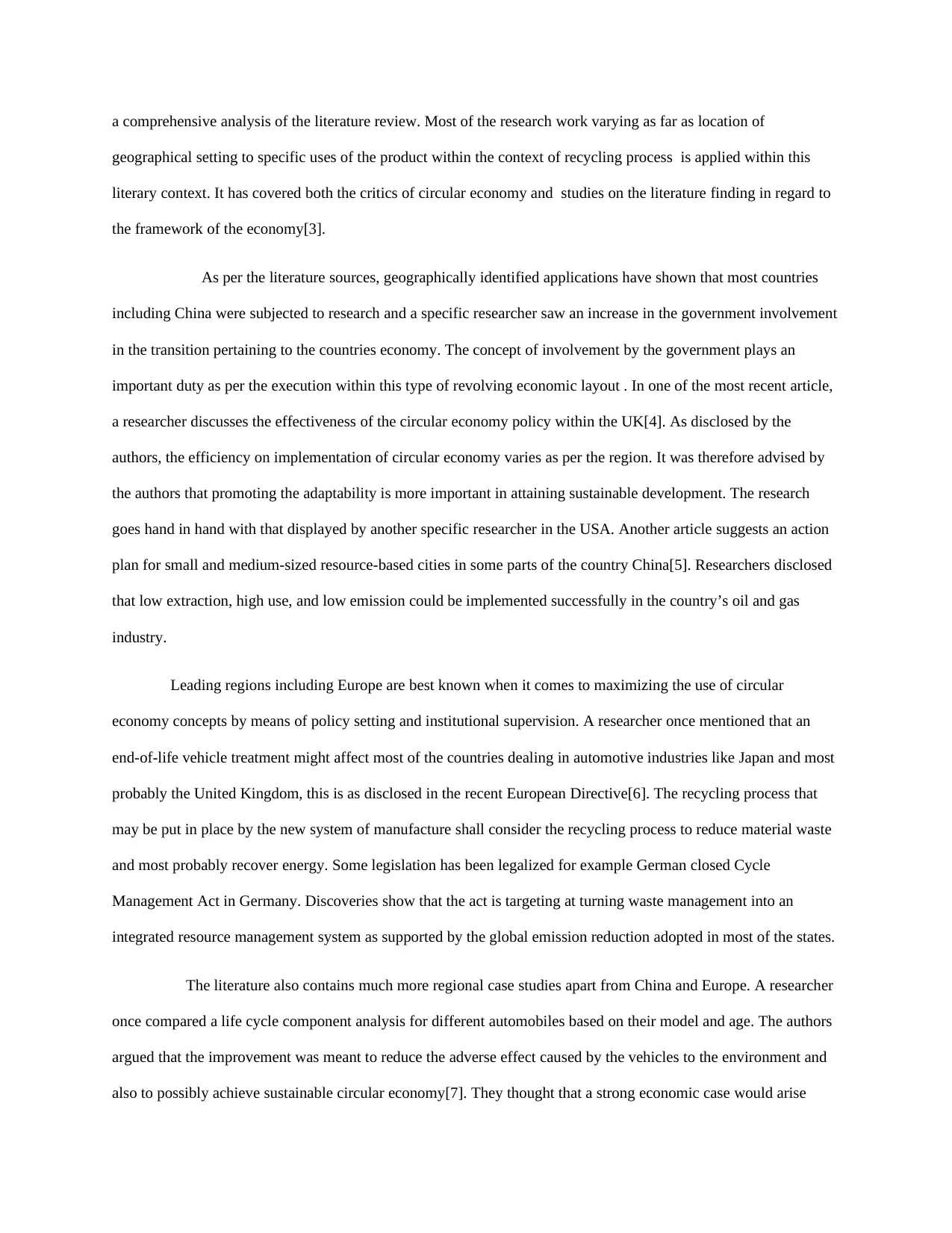
a comprehensive analysis of the literature review. Most of the research work varying as far as location of
geographical setting to specific uses of the product within the context of recycling process is applied within this
literary context. It has covered both the critics of circular economy and studies on the literature finding in regard to
the framework of the economy[3].
As per the literature sources, geographically identified applications have shown that most countries
including China were subjected to research and a specific researcher saw an increase in the government involvement
in the transition pertaining to the countries economy. The concept of involvement by the government plays an
important duty as per the execution within this type of revolving economic layout . In one of the most recent article,
a researcher discusses the effectiveness of the circular economy policy within the UK[4]. As disclosed by the
authors, the efficiency on implementation of circular economy varies as per the region. It was therefore advised by
the authors that promoting the adaptability is more important in attaining sustainable development. The research
goes hand in hand with that displayed by another specific researcher in the USA. Another article suggests an action
plan for small and medium-sized resource-based cities in some parts of the country China[5]. Researchers disclosed
that low extraction, high use, and low emission could be implemented successfully in the country’s oil and gas
industry.
Leading regions including Europe are best known when it comes to maximizing the use of circular
economy concepts by means of policy setting and institutional supervision. A researcher once mentioned that an
end-of-life vehicle treatment might affect most of the countries dealing in automotive industries like Japan and most
probably the United Kingdom, this is as disclosed in the recent European Directive[6]. The recycling process that
may be put in place by the new system of manufacture shall consider the recycling process to reduce material waste
and most probably recover energy. Some legislation has been legalized for example German closed Cycle
Management Act in Germany. Discoveries show that the act is targeting at turning waste management into an
integrated resource management system as supported by the global emission reduction adopted in most of the states.
The literature also contains much more regional case studies apart from China and Europe. A researcher
once compared a life cycle component analysis for different automobiles based on their model and age. The authors
argued that the improvement was meant to reduce the adverse effect caused by the vehicles to the environment and
also to possibly achieve sustainable circular economy[7]. They thought that a strong economic case would arise
geographical setting to specific uses of the product within the context of recycling process is applied within this
literary context. It has covered both the critics of circular economy and studies on the literature finding in regard to
the framework of the economy[3].
As per the literature sources, geographically identified applications have shown that most countries
including China were subjected to research and a specific researcher saw an increase in the government involvement
in the transition pertaining to the countries economy. The concept of involvement by the government plays an
important duty as per the execution within this type of revolving economic layout . In one of the most recent article,
a researcher discusses the effectiveness of the circular economy policy within the UK[4]. As disclosed by the
authors, the efficiency on implementation of circular economy varies as per the region. It was therefore advised by
the authors that promoting the adaptability is more important in attaining sustainable development. The research
goes hand in hand with that displayed by another specific researcher in the USA. Another article suggests an action
plan for small and medium-sized resource-based cities in some parts of the country China[5]. Researchers disclosed
that low extraction, high use, and low emission could be implemented successfully in the country’s oil and gas
industry.
Leading regions including Europe are best known when it comes to maximizing the use of circular
economy concepts by means of policy setting and institutional supervision. A researcher once mentioned that an
end-of-life vehicle treatment might affect most of the countries dealing in automotive industries like Japan and most
probably the United Kingdom, this is as disclosed in the recent European Directive[6]. The recycling process that
may be put in place by the new system of manufacture shall consider the recycling process to reduce material waste
and most probably recover energy. Some legislation has been legalized for example German closed Cycle
Management Act in Germany. Discoveries show that the act is targeting at turning waste management into an
integrated resource management system as supported by the global emission reduction adopted in most of the states.
The literature also contains much more regional case studies apart from China and Europe. A researcher
once compared a life cycle component analysis for different automobiles based on their model and age. The authors
argued that the improvement was meant to reduce the adverse effect caused by the vehicles to the environment and
also to possibly achieve sustainable circular economy[7]. They thought that a strong economic case would arise
Paraphrase This Document
Need a fresh take? Get an instant paraphrase of this document with our AI Paraphraser
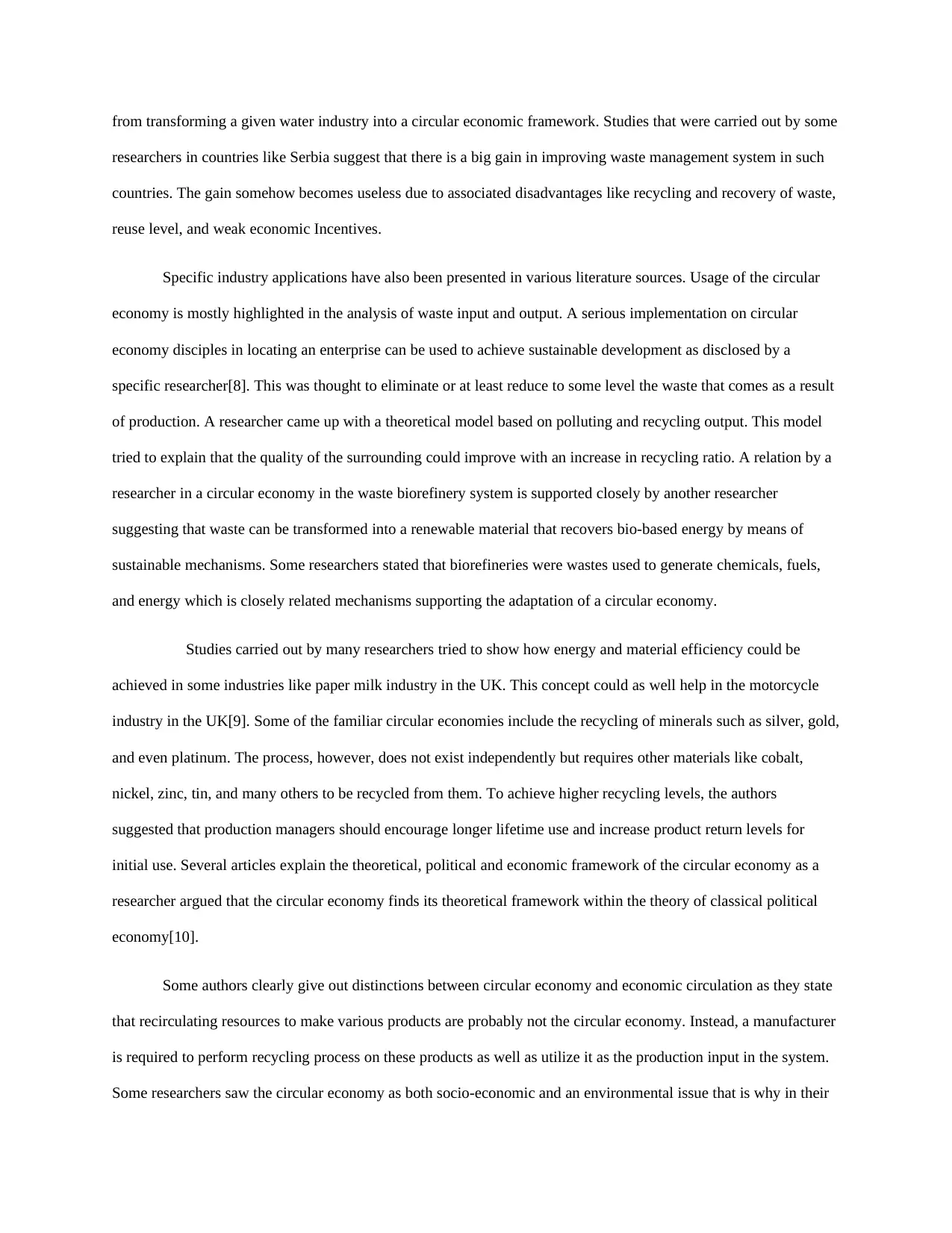
from transforming a given water industry into a circular economic framework. Studies that were carried out by some
researchers in countries like Serbia suggest that there is a big gain in improving waste management system in such
countries. The gain somehow becomes useless due to associated disadvantages like recycling and recovery of waste,
reuse level, and weak economic Incentives.
Specific industry applications have also been presented in various literature sources. Usage of the circular
economy is mostly highlighted in the analysis of waste input and output. A serious implementation on circular
economy disciples in locating an enterprise can be used to achieve sustainable development as disclosed by a
specific researcher[8]. This was thought to eliminate or at least reduce to some level the waste that comes as a result
of production. A researcher came up with a theoretical model based on polluting and recycling output. This model
tried to explain that the quality of the surrounding could improve with an increase in recycling ratio. A relation by a
researcher in a circular economy in the waste biorefinery system is supported closely by another researcher
suggesting that waste can be transformed into a renewable material that recovers bio-based energy by means of
sustainable mechanisms. Some researchers stated that biorefineries were wastes used to generate chemicals, fuels,
and energy which is closely related mechanisms supporting the adaptation of a circular economy.
Studies carried out by many researchers tried to show how energy and material efficiency could be
achieved in some industries like paper milk industry in the UK. This concept could as well help in the motorcycle
industry in the UK[9]. Some of the familiar circular economies include the recycling of minerals such as silver, gold,
and even platinum. The process, however, does not exist independently but requires other materials like cobalt,
nickel, zinc, tin, and many others to be recycled from them. To achieve higher recycling levels, the authors
suggested that production managers should encourage longer lifetime use and increase product return levels for
initial use. Several articles explain the theoretical, political and economic framework of the circular economy as a
researcher argued that the circular economy finds its theoretical framework within the theory of classical political
economy[10].
Some authors clearly give out distinctions between circular economy and economic circulation as they state
that recirculating resources to make various products are probably not the circular economy. Instead, a manufacturer
is required to perform recycling process on these products as well as utilize it as the production input in the system.
Some researchers saw the circular economy as both socio-economic and an environmental issue that is why in their
researchers in countries like Serbia suggest that there is a big gain in improving waste management system in such
countries. The gain somehow becomes useless due to associated disadvantages like recycling and recovery of waste,
reuse level, and weak economic Incentives.
Specific industry applications have also been presented in various literature sources. Usage of the circular
economy is mostly highlighted in the analysis of waste input and output. A serious implementation on circular
economy disciples in locating an enterprise can be used to achieve sustainable development as disclosed by a
specific researcher[8]. This was thought to eliminate or at least reduce to some level the waste that comes as a result
of production. A researcher came up with a theoretical model based on polluting and recycling output. This model
tried to explain that the quality of the surrounding could improve with an increase in recycling ratio. A relation by a
researcher in a circular economy in the waste biorefinery system is supported closely by another researcher
suggesting that waste can be transformed into a renewable material that recovers bio-based energy by means of
sustainable mechanisms. Some researchers stated that biorefineries were wastes used to generate chemicals, fuels,
and energy which is closely related mechanisms supporting the adaptation of a circular economy.
Studies carried out by many researchers tried to show how energy and material efficiency could be
achieved in some industries like paper milk industry in the UK. This concept could as well help in the motorcycle
industry in the UK[9]. Some of the familiar circular economies include the recycling of minerals such as silver, gold,
and even platinum. The process, however, does not exist independently but requires other materials like cobalt,
nickel, zinc, tin, and many others to be recycled from them. To achieve higher recycling levels, the authors
suggested that production managers should encourage longer lifetime use and increase product return levels for
initial use. Several articles explain the theoretical, political and economic framework of the circular economy as a
researcher argued that the circular economy finds its theoretical framework within the theory of classical political
economy[10].
Some authors clearly give out distinctions between circular economy and economic circulation as they state
that recirculating resources to make various products are probably not the circular economy. Instead, a manufacturer
is required to perform recycling process on these products as well as utilize it as the production input in the system.
Some researchers saw the circular economy as both socio-economic and an environmental issue that is why in their
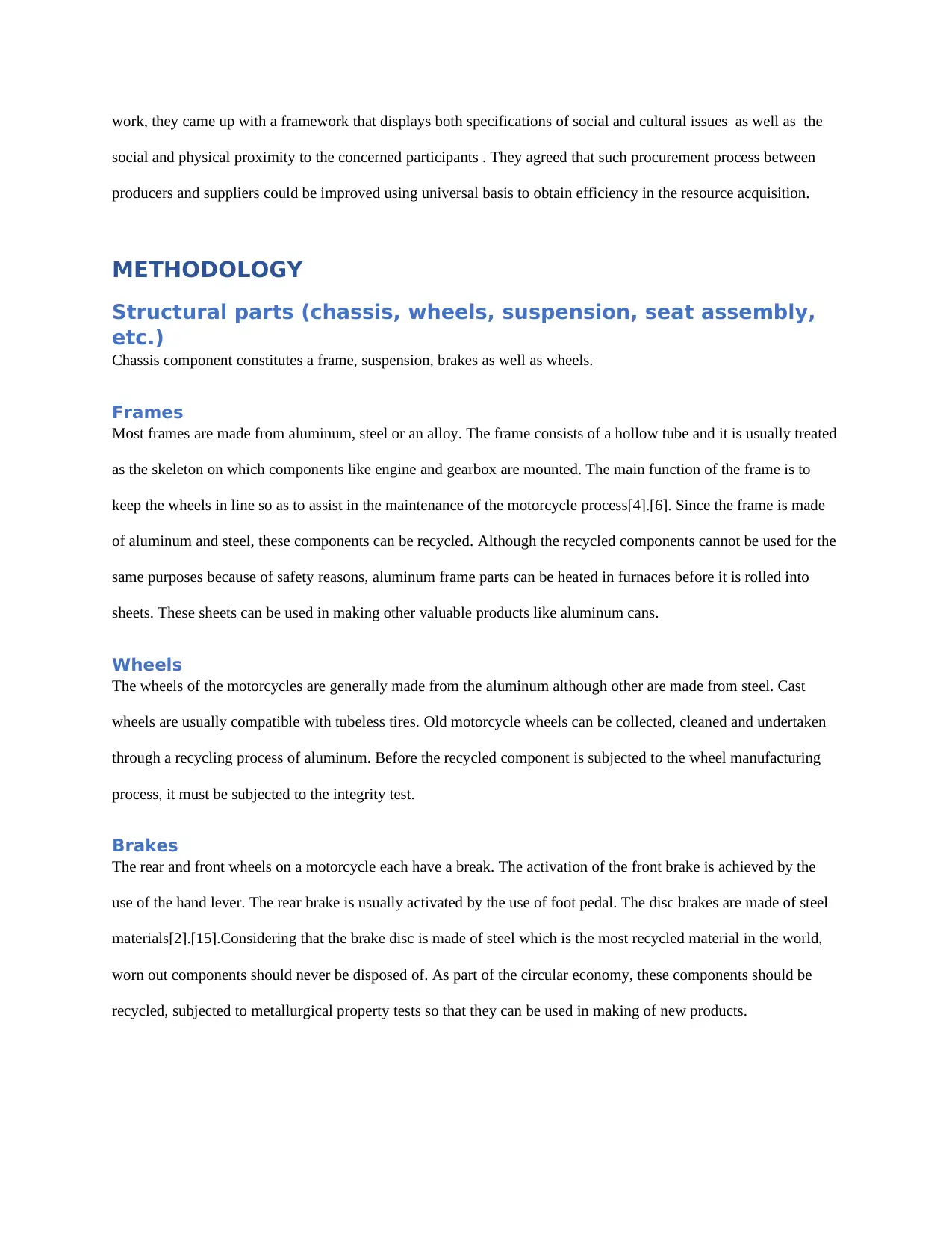
work, they came up with a framework that displays both specifications of social and cultural issues as well as the
social and physical proximity to the concerned participants . They agreed that such procurement process between
producers and suppliers could be improved using universal basis to obtain efficiency in the resource acquisition.
METHODOLOGY
Structural parts (chassis, wheels, suspension, seat assembly,
etc.)
Chassis component constitutes a frame, suspension, brakes as well as wheels.
Frames
Most frames are made from aluminum, steel or an alloy. The frame consists of a hollow tube and it is usually treated
as the skeleton on which components like engine and gearbox are mounted. The main function of the frame is to
keep the wheels in line so as to assist in the maintenance of the motorcycle process[4].[6]. Since the frame is made
of aluminum and steel, these components can be recycled. Although the recycled components cannot be used for the
same purposes because of safety reasons, aluminum frame parts can be heated in furnaces before it is rolled into
sheets. These sheets can be used in making other valuable products like aluminum cans.
Wheels
The wheels of the motorcycles are generally made from the aluminum although other are made from steel. Cast
wheels are usually compatible with tubeless tires. Old motorcycle wheels can be collected, cleaned and undertaken
through a recycling process of aluminum. Before the recycled component is subjected to the wheel manufacturing
process, it must be subjected to the integrity test.
Brakes
The rear and front wheels on a motorcycle each have a break. The activation of the front brake is achieved by the
use of the hand lever. The rear brake is usually activated by the use of foot pedal. The disc brakes are made of steel
materials[2].[15].Considering that the brake disc is made of steel which is the most recycled material in the world,
worn out components should never be disposed of. As part of the circular economy, these components should be
recycled, subjected to metallurgical property tests so that they can be used in making of new products.
social and physical proximity to the concerned participants . They agreed that such procurement process between
producers and suppliers could be improved using universal basis to obtain efficiency in the resource acquisition.
METHODOLOGY
Structural parts (chassis, wheels, suspension, seat assembly,
etc.)
Chassis component constitutes a frame, suspension, brakes as well as wheels.
Frames
Most frames are made from aluminum, steel or an alloy. The frame consists of a hollow tube and it is usually treated
as the skeleton on which components like engine and gearbox are mounted. The main function of the frame is to
keep the wheels in line so as to assist in the maintenance of the motorcycle process[4].[6]. Since the frame is made
of aluminum and steel, these components can be recycled. Although the recycled components cannot be used for the
same purposes because of safety reasons, aluminum frame parts can be heated in furnaces before it is rolled into
sheets. These sheets can be used in making other valuable products like aluminum cans.
Wheels
The wheels of the motorcycles are generally made from the aluminum although other are made from steel. Cast
wheels are usually compatible with tubeless tires. Old motorcycle wheels can be collected, cleaned and undertaken
through a recycling process of aluminum. Before the recycled component is subjected to the wheel manufacturing
process, it must be subjected to the integrity test.
Brakes
The rear and front wheels on a motorcycle each have a break. The activation of the front brake is achieved by the
use of the hand lever. The rear brake is usually activated by the use of foot pedal. The disc brakes are made of steel
materials[2].[15].Considering that the brake disc is made of steel which is the most recycled material in the world,
worn out components should never be disposed of. As part of the circular economy, these components should be
recycled, subjected to metallurgical property tests so that they can be used in making of new products.
⊘ This is a preview!⊘
Do you want full access?
Subscribe today to unlock all pages.

Trusted by 1+ million students worldwide
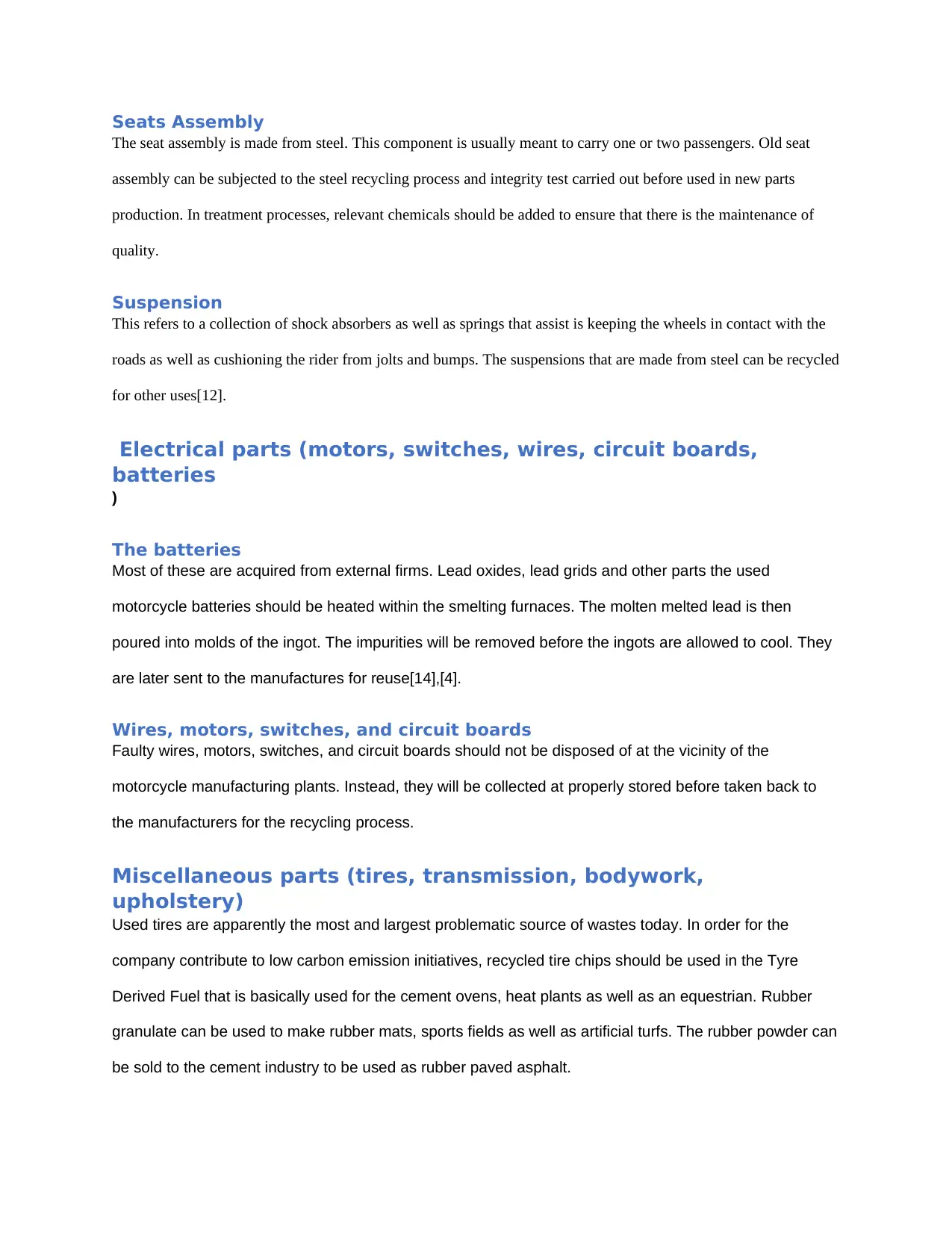
Seats Assembly
The seat assembly is made from steel. This component is usually meant to carry one or two passengers. Old seat
assembly can be subjected to the steel recycling process and integrity test carried out before used in new parts
production. In treatment processes, relevant chemicals should be added to ensure that there is the maintenance of
quality.
Suspension
This refers to a collection of shock absorbers as well as springs that assist is keeping the wheels in contact with the
roads as well as cushioning the rider from jolts and bumps. The suspensions that are made from steel can be recycled
for other uses[12].
Electrical parts (motors, switches, wires, circuit boards,
batteries
)
The batteries
Most of these are acquired from external firms. Lead oxides, lead grids and other parts the used
motorcycle batteries should be heated within the smelting furnaces. The molten melted lead is then
poured into molds of the ingot. The impurities will be removed before the ingots are allowed to cool. They
are later sent to the manufactures for reuse[14],[4].
Wires, motors, switches, and circuit boards
Faulty wires, motors, switches, and circuit boards should not be disposed of at the vicinity of the
motorcycle manufacturing plants. Instead, they will be collected at properly stored before taken back to
the manufacturers for the recycling process.
Miscellaneous parts (tires, transmission, bodywork,
upholstery)
Used tires are apparently the most and largest problematic source of wastes today. In order for the
company contribute to low carbon emission initiatives, recycled tire chips should be used in the Tyre
Derived Fuel that is basically used for the cement ovens, heat plants as well as an equestrian. Rubber
granulate can be used to make rubber mats, sports fields as well as artificial turfs. The rubber powder can
be sold to the cement industry to be used as rubber paved asphalt.
The seat assembly is made from steel. This component is usually meant to carry one or two passengers. Old seat
assembly can be subjected to the steel recycling process and integrity test carried out before used in new parts
production. In treatment processes, relevant chemicals should be added to ensure that there is the maintenance of
quality.
Suspension
This refers to a collection of shock absorbers as well as springs that assist is keeping the wheels in contact with the
roads as well as cushioning the rider from jolts and bumps. The suspensions that are made from steel can be recycled
for other uses[12].
Electrical parts (motors, switches, wires, circuit boards,
batteries
)
The batteries
Most of these are acquired from external firms. Lead oxides, lead grids and other parts the used
motorcycle batteries should be heated within the smelting furnaces. The molten melted lead is then
poured into molds of the ingot. The impurities will be removed before the ingots are allowed to cool. They
are later sent to the manufactures for reuse[14],[4].
Wires, motors, switches, and circuit boards
Faulty wires, motors, switches, and circuit boards should not be disposed of at the vicinity of the
motorcycle manufacturing plants. Instead, they will be collected at properly stored before taken back to
the manufacturers for the recycling process.
Miscellaneous parts (tires, transmission, bodywork,
upholstery)
Used tires are apparently the most and largest problematic source of wastes today. In order for the
company contribute to low carbon emission initiatives, recycled tire chips should be used in the Tyre
Derived Fuel that is basically used for the cement ovens, heat plants as well as an equestrian. Rubber
granulate can be used to make rubber mats, sports fields as well as artificial turfs. The rubber powder can
be sold to the cement industry to be used as rubber paved asphalt.
Paraphrase This Document
Need a fresh take? Get an instant paraphrase of this document with our AI Paraphraser
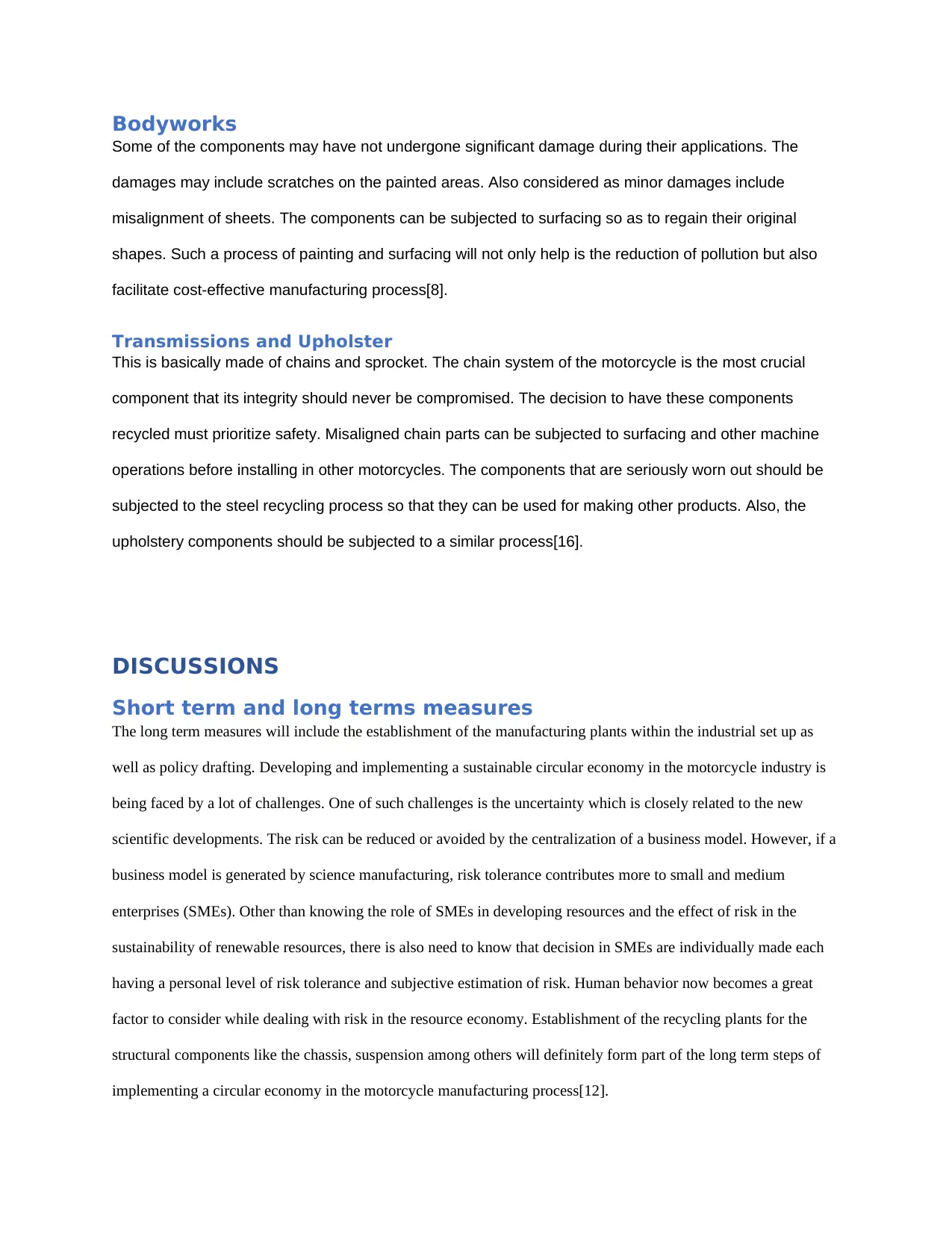
Bodyworks
Some of the components may have not undergone significant damage during their applications. The
damages may include scratches on the painted areas. Also considered as minor damages include
misalignment of sheets. The components can be subjected to surfacing so as to regain their original
shapes. Such a process of painting and surfacing will not only help is the reduction of pollution but also
facilitate cost-effective manufacturing process[8].
Transmissions and Upholster
This is basically made of chains and sprocket. The chain system of the motorcycle is the most crucial
component that its integrity should never be compromised. The decision to have these components
recycled must prioritize safety. Misaligned chain parts can be subjected to surfacing and other machine
operations before installing in other motorcycles. The components that are seriously worn out should be
subjected to the steel recycling process so that they can be used for making other products. Also, the
upholstery components should be subjected to a similar process[16].
DISCUSSIONS
Short term and long terms measures
The long term measures will include the establishment of the manufacturing plants within the industrial set up as
well as policy drafting. Developing and implementing a sustainable circular economy in the motorcycle industry is
being faced by a lot of challenges. One of such challenges is the uncertainty which is closely related to the new
scientific developments. The risk can be reduced or avoided by the centralization of a business model. However, if a
business model is generated by science manufacturing, risk tolerance contributes more to small and medium
enterprises (SMEs). Other than knowing the role of SMEs in developing resources and the effect of risk in the
sustainability of renewable resources, there is also need to know that decision in SMEs are individually made each
having a personal level of risk tolerance and subjective estimation of risk. Human behavior now becomes a great
factor to consider while dealing with risk in the resource economy. Establishment of the recycling plants for the
structural components like the chassis, suspension among others will definitely form part of the long term steps of
implementing a circular economy in the motorcycle manufacturing process[12].
Some of the components may have not undergone significant damage during their applications. The
damages may include scratches on the painted areas. Also considered as minor damages include
misalignment of sheets. The components can be subjected to surfacing so as to regain their original
shapes. Such a process of painting and surfacing will not only help is the reduction of pollution but also
facilitate cost-effective manufacturing process[8].
Transmissions and Upholster
This is basically made of chains and sprocket. The chain system of the motorcycle is the most crucial
component that its integrity should never be compromised. The decision to have these components
recycled must prioritize safety. Misaligned chain parts can be subjected to surfacing and other machine
operations before installing in other motorcycles. The components that are seriously worn out should be
subjected to the steel recycling process so that they can be used for making other products. Also, the
upholstery components should be subjected to a similar process[16].
DISCUSSIONS
Short term and long terms measures
The long term measures will include the establishment of the manufacturing plants within the industrial set up as
well as policy drafting. Developing and implementing a sustainable circular economy in the motorcycle industry is
being faced by a lot of challenges. One of such challenges is the uncertainty which is closely related to the new
scientific developments. The risk can be reduced or avoided by the centralization of a business model. However, if a
business model is generated by science manufacturing, risk tolerance contributes more to small and medium
enterprises (SMEs). Other than knowing the role of SMEs in developing resources and the effect of risk in the
sustainability of renewable resources, there is also need to know that decision in SMEs are individually made each
having a personal level of risk tolerance and subjective estimation of risk. Human behavior now becomes a great
factor to consider while dealing with risk in the resource economy. Establishment of the recycling plants for the
structural components like the chassis, suspension among others will definitely form part of the long term steps of
implementing a circular economy in the motorcycle manufacturing process[12].
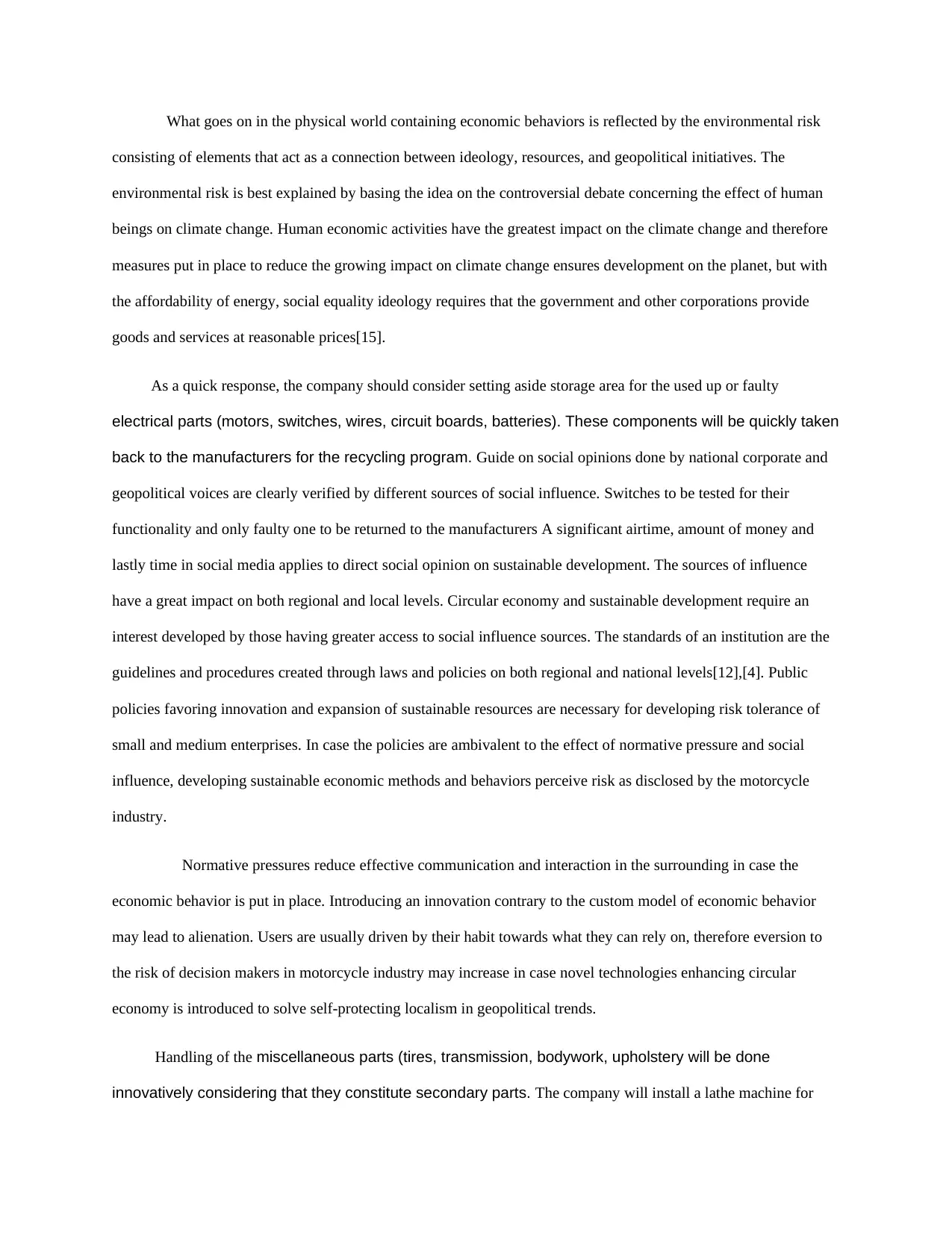
What goes on in the physical world containing economic behaviors is reflected by the environmental risk
consisting of elements that act as a connection between ideology, resources, and geopolitical initiatives. The
environmental risk is best explained by basing the idea on the controversial debate concerning the effect of human
beings on climate change. Human economic activities have the greatest impact on the climate change and therefore
measures put in place to reduce the growing impact on climate change ensures development on the planet, but with
the affordability of energy, social equality ideology requires that the government and other corporations provide
goods and services at reasonable prices[15].
As a quick response, the company should consider setting aside storage area for the used up or faulty
electrical parts (motors, switches, wires, circuit boards, batteries). These components will be quickly taken
back to the manufacturers for the recycling program. Guide on social opinions done by national corporate and
geopolitical voices are clearly verified by different sources of social influence. Switches to be tested for their
functionality and only faulty one to be returned to the manufacturers A significant airtime, amount of money and
lastly time in social media applies to direct social opinion on sustainable development. The sources of influence
have a great impact on both regional and local levels. Circular economy and sustainable development require an
interest developed by those having greater access to social influence sources. The standards of an institution are the
guidelines and procedures created through laws and policies on both regional and national levels[12],[4]. Public
policies favoring innovation and expansion of sustainable resources are necessary for developing risk tolerance of
small and medium enterprises. In case the policies are ambivalent to the effect of normative pressure and social
influence, developing sustainable economic methods and behaviors perceive risk as disclosed by the motorcycle
industry.
Normative pressures reduce effective communication and interaction in the surrounding in case the
economic behavior is put in place. Introducing an innovation contrary to the custom model of economic behavior
may lead to alienation. Users are usually driven by their habit towards what they can rely on, therefore eversion to
the risk of decision makers in motorcycle industry may increase in case novel technologies enhancing circular
economy is introduced to solve self-protecting localism in geopolitical trends.
Handling of the miscellaneous parts (tires, transmission, bodywork, upholstery will be done
innovatively considering that they constitute secondary parts. The company will install a lathe machine for
consisting of elements that act as a connection between ideology, resources, and geopolitical initiatives. The
environmental risk is best explained by basing the idea on the controversial debate concerning the effect of human
beings on climate change. Human economic activities have the greatest impact on the climate change and therefore
measures put in place to reduce the growing impact on climate change ensures development on the planet, but with
the affordability of energy, social equality ideology requires that the government and other corporations provide
goods and services at reasonable prices[15].
As a quick response, the company should consider setting aside storage area for the used up or faulty
electrical parts (motors, switches, wires, circuit boards, batteries). These components will be quickly taken
back to the manufacturers for the recycling program. Guide on social opinions done by national corporate and
geopolitical voices are clearly verified by different sources of social influence. Switches to be tested for their
functionality and only faulty one to be returned to the manufacturers A significant airtime, amount of money and
lastly time in social media applies to direct social opinion on sustainable development. The sources of influence
have a great impact on both regional and local levels. Circular economy and sustainable development require an
interest developed by those having greater access to social influence sources. The standards of an institution are the
guidelines and procedures created through laws and policies on both regional and national levels[12],[4]. Public
policies favoring innovation and expansion of sustainable resources are necessary for developing risk tolerance of
small and medium enterprises. In case the policies are ambivalent to the effect of normative pressure and social
influence, developing sustainable economic methods and behaviors perceive risk as disclosed by the motorcycle
industry.
Normative pressures reduce effective communication and interaction in the surrounding in case the
economic behavior is put in place. Introducing an innovation contrary to the custom model of economic behavior
may lead to alienation. Users are usually driven by their habit towards what they can rely on, therefore eversion to
the risk of decision makers in motorcycle industry may increase in case novel technologies enhancing circular
economy is introduced to solve self-protecting localism in geopolitical trends.
Handling of the miscellaneous parts (tires, transmission, bodywork, upholstery will be done
innovatively considering that they constitute secondary parts. The company will install a lathe machine for
⊘ This is a preview!⊘
Do you want full access?
Subscribe today to unlock all pages.

Trusted by 1+ million students worldwide
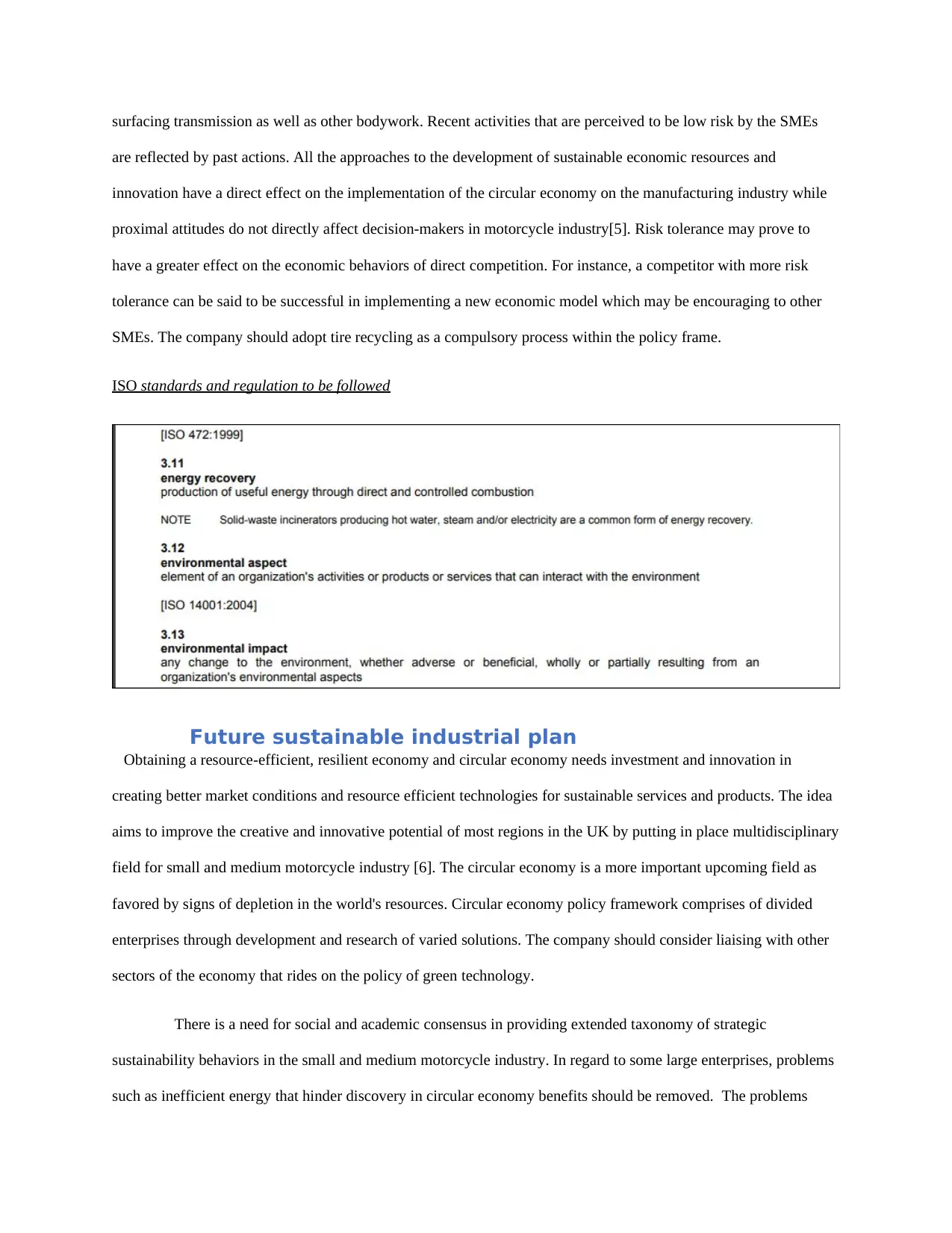
surfacing transmission as well as other bodywork. Recent activities that are perceived to be low risk by the SMEs
are reflected by past actions. All the approaches to the development of sustainable economic resources and
innovation have a direct effect on the implementation of the circular economy on the manufacturing industry while
proximal attitudes do not directly affect decision-makers in motorcycle industry[5]. Risk tolerance may prove to
have a greater effect on the economic behaviors of direct competition. For instance, a competitor with more risk
tolerance can be said to be successful in implementing a new economic model which may be encouraging to other
SMEs. The company should adopt tire recycling as a compulsory process within the policy frame.
ISO standards and regulation to be followed
Future sustainable industrial plan
Obtaining a resource-efficient, resilient economy and circular economy needs investment and innovation in
creating better market conditions and resource efficient technologies for sustainable services and products. The idea
aims to improve the creative and innovative potential of most regions in the UK by putting in place multidisciplinary
field for small and medium motorcycle industry [6]. The circular economy is a more important upcoming field as
favored by signs of depletion in the world's resources. Circular economy policy framework comprises of divided
enterprises through development and research of varied solutions. The company should consider liaising with other
sectors of the economy that rides on the policy of green technology.
There is a need for social and academic consensus in providing extended taxonomy of strategic
sustainability behaviors in the small and medium motorcycle industry. In regard to some large enterprises, problems
such as inefficient energy that hinder discovery in circular economy benefits should be removed. The problems
are reflected by past actions. All the approaches to the development of sustainable economic resources and
innovation have a direct effect on the implementation of the circular economy on the manufacturing industry while
proximal attitudes do not directly affect decision-makers in motorcycle industry[5]. Risk tolerance may prove to
have a greater effect on the economic behaviors of direct competition. For instance, a competitor with more risk
tolerance can be said to be successful in implementing a new economic model which may be encouraging to other
SMEs. The company should adopt tire recycling as a compulsory process within the policy frame.
ISO standards and regulation to be followed
Future sustainable industrial plan
Obtaining a resource-efficient, resilient economy and circular economy needs investment and innovation in
creating better market conditions and resource efficient technologies for sustainable services and products. The idea
aims to improve the creative and innovative potential of most regions in the UK by putting in place multidisciplinary
field for small and medium motorcycle industry [6]. The circular economy is a more important upcoming field as
favored by signs of depletion in the world's resources. Circular economy policy framework comprises of divided
enterprises through development and research of varied solutions. The company should consider liaising with other
sectors of the economy that rides on the policy of green technology.
There is a need for social and academic consensus in providing extended taxonomy of strategic
sustainability behaviors in the small and medium motorcycle industry. In regard to some large enterprises, problems
such as inefficient energy that hinder discovery in circular economy benefits should be removed. The problems
Paraphrase This Document
Need a fresh take? Get an instant paraphrase of this document with our AI Paraphraser
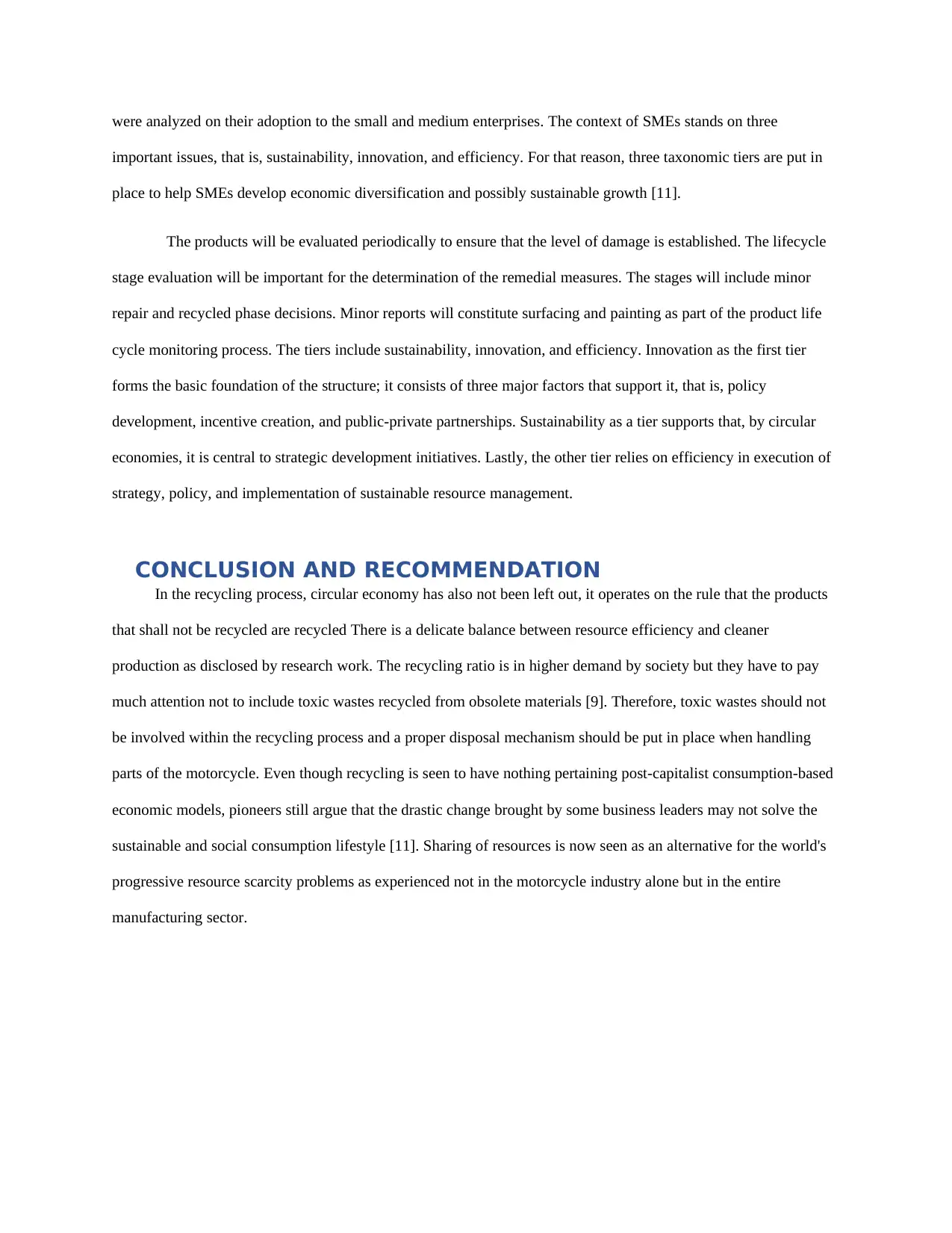
were analyzed on their adoption to the small and medium enterprises. The context of SMEs stands on three
important issues, that is, sustainability, innovation, and efficiency. For that reason, three taxonomic tiers are put in
place to help SMEs develop economic diversification and possibly sustainable growth [11].
The products will be evaluated periodically to ensure that the level of damage is established. The lifecycle
stage evaluation will be important for the determination of the remedial measures. The stages will include minor
repair and recycled phase decisions. Minor reports will constitute surfacing and painting as part of the product life
cycle monitoring process. The tiers include sustainability, innovation, and efficiency. Innovation as the first tier
forms the basic foundation of the structure; it consists of three major factors that support it, that is, policy
development, incentive creation, and public-private partnerships. Sustainability as a tier supports that, by circular
economies, it is central to strategic development initiatives. Lastly, the other tier relies on efficiency in execution of
strategy, policy, and implementation of sustainable resource management.
CONCLUSION AND RECOMMENDATION
In the recycling process, circular economy has also not been left out, it operates on the rule that the products
that shall not be recycled are recycled There is a delicate balance between resource efficiency and cleaner
production as disclosed by research work. The recycling ratio is in higher demand by society but they have to pay
much attention not to include toxic wastes recycled from obsolete materials [9]. Therefore, toxic wastes should not
be involved within the recycling process and a proper disposal mechanism should be put in place when handling
parts of the motorcycle. Even though recycling is seen to have nothing pertaining post-capitalist consumption-based
economic models, pioneers still argue that the drastic change brought by some business leaders may not solve the
sustainable and social consumption lifestyle [11]. Sharing of resources is now seen as an alternative for the world's
progressive resource scarcity problems as experienced not in the motorcycle industry alone but in the entire
manufacturing sector.
important issues, that is, sustainability, innovation, and efficiency. For that reason, three taxonomic tiers are put in
place to help SMEs develop economic diversification and possibly sustainable growth [11].
The products will be evaluated periodically to ensure that the level of damage is established. The lifecycle
stage evaluation will be important for the determination of the remedial measures. The stages will include minor
repair and recycled phase decisions. Minor reports will constitute surfacing and painting as part of the product life
cycle monitoring process. The tiers include sustainability, innovation, and efficiency. Innovation as the first tier
forms the basic foundation of the structure; it consists of three major factors that support it, that is, policy
development, incentive creation, and public-private partnerships. Sustainability as a tier supports that, by circular
economies, it is central to strategic development initiatives. Lastly, the other tier relies on efficiency in execution of
strategy, policy, and implementation of sustainable resource management.
CONCLUSION AND RECOMMENDATION
In the recycling process, circular economy has also not been left out, it operates on the rule that the products
that shall not be recycled are recycled There is a delicate balance between resource efficiency and cleaner
production as disclosed by research work. The recycling ratio is in higher demand by society but they have to pay
much attention not to include toxic wastes recycled from obsolete materials [9]. Therefore, toxic wastes should not
be involved within the recycling process and a proper disposal mechanism should be put in place when handling
parts of the motorcycle. Even though recycling is seen to have nothing pertaining post-capitalist consumption-based
economic models, pioneers still argue that the drastic change brought by some business leaders may not solve the
sustainable and social consumption lifestyle [11]. Sharing of resources is now seen as an alternative for the world's
progressive resource scarcity problems as experienced not in the motorcycle industry alone but in the entire
manufacturing sector.
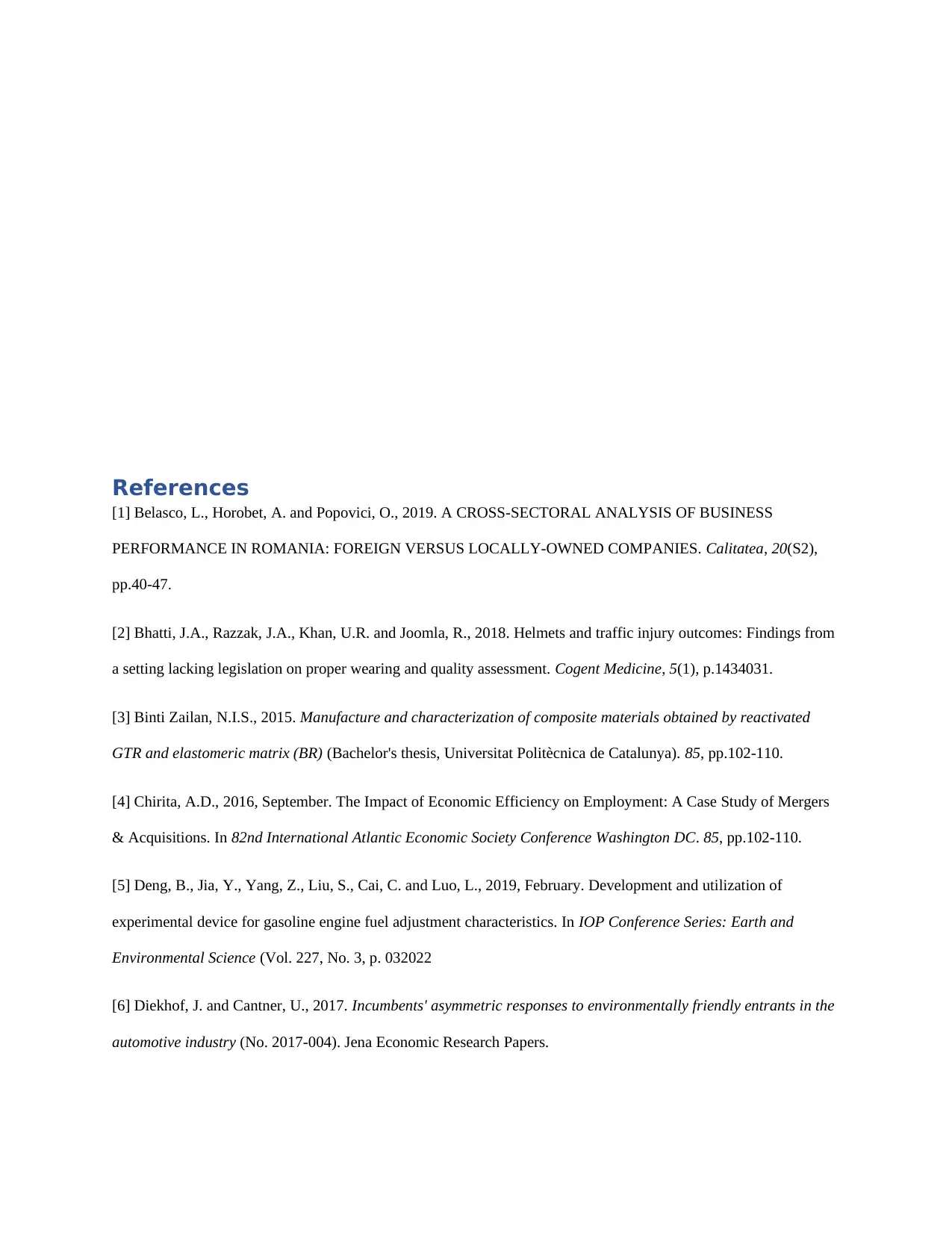
References
[1] Belasco, L., Horobet, A. and Popovici, O., 2019. A CROSS-SECTORAL ANALYSIS OF BUSINESS
PERFORMANCE IN ROMANIA: FOREIGN VERSUS LOCALLY-OWNED COMPANIES. Calitatea, 20(S2),
pp.40-47.
[2] Bhatti, J.A., Razzak, J.A., Khan, U.R. and Joomla, R., 2018. Helmets and traffic injury outcomes: Findings from
a setting lacking legislation on proper wearing and quality assessment. Cogent Medicine, 5(1), p.1434031.
[3] Binti Zailan, N.I.S., 2015. Manufacture and characterization of composite materials obtained by reactivated
GTR and elastomeric matrix (BR) (Bachelor's thesis, Universitat Politècnica de Catalunya). 85, pp.102-110.
[4] Chirita, A.D., 2016, September. The Impact of Economic Efficiency on Employment: A Case Study of Mergers
& Acquisitions. In 82nd International Atlantic Economic Society Conference Washington DC. 85, pp.102-110.
[5] Deng, B., Jia, Y., Yang, Z., Liu, S., Cai, C. and Luo, L., 2019, February. Development and utilization of
experimental device for gasoline engine fuel adjustment characteristics. In IOP Conference Series: Earth and
Environmental Science (Vol. 227, No. 3, p. 032022
[6] Diekhof, J. and Cantner, U., 2017. Incumbents' asymmetric responses to environmentally friendly entrants in the
automotive industry (No. 2017-004). Jena Economic Research Papers.
[1] Belasco, L., Horobet, A. and Popovici, O., 2019. A CROSS-SECTORAL ANALYSIS OF BUSINESS
PERFORMANCE IN ROMANIA: FOREIGN VERSUS LOCALLY-OWNED COMPANIES. Calitatea, 20(S2),
pp.40-47.
[2] Bhatti, J.A., Razzak, J.A., Khan, U.R. and Joomla, R., 2018. Helmets and traffic injury outcomes: Findings from
a setting lacking legislation on proper wearing and quality assessment. Cogent Medicine, 5(1), p.1434031.
[3] Binti Zailan, N.I.S., 2015. Manufacture and characterization of composite materials obtained by reactivated
GTR and elastomeric matrix (BR) (Bachelor's thesis, Universitat Politècnica de Catalunya). 85, pp.102-110.
[4] Chirita, A.D., 2016, September. The Impact of Economic Efficiency on Employment: A Case Study of Mergers
& Acquisitions. In 82nd International Atlantic Economic Society Conference Washington DC. 85, pp.102-110.
[5] Deng, B., Jia, Y., Yang, Z., Liu, S., Cai, C. and Luo, L., 2019, February. Development and utilization of
experimental device for gasoline engine fuel adjustment characteristics. In IOP Conference Series: Earth and
Environmental Science (Vol. 227, No. 3, p. 032022
[6] Diekhof, J. and Cantner, U., 2017. Incumbents' asymmetric responses to environmentally friendly entrants in the
automotive industry (No. 2017-004). Jena Economic Research Papers.
⊘ This is a preview!⊘
Do you want full access?
Subscribe today to unlock all pages.

Trusted by 1+ million students worldwide
1 out of 17
Related Documents
Your All-in-One AI-Powered Toolkit for Academic Success.
+13062052269
info@desklib.com
Available 24*7 on WhatsApp / Email
![[object Object]](/_next/static/media/star-bottom.7253800d.svg)
Unlock your academic potential
Copyright © 2020–2025 A2Z Services. All Rights Reserved. Developed and managed by ZUCOL.





